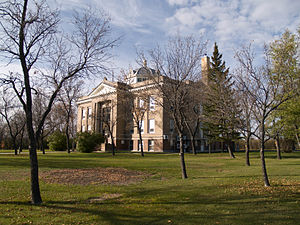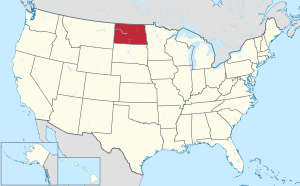Mountrail County, North Dakota
County in North Dakota, United States From Wikipedia, the free encyclopedia
County in North Dakota, United States From Wikipedia, the free encyclopedia
Mountrail County is a county in the northwestern part of North Dakota, United States. As of the 2020 census, the population was 9,809.[1] Its county seat is Stanley.[2] The county was originally created in 1873, then removed in 1892, annexed by Ward County. It was re-created and organized in 1909.[3][4] The county is home to the headquarters of the Three Affiliated Tribes of the Mandan, Hidatsa, and Arikara people, and a large part of the county belongs to the tribe's Fort Berthold reservation.[5][6]
Mountrail County | |
|---|---|
 Mountrail County Courthouse in Stanley | |
 Location within the U.S. state of North Dakota | |
 North Dakota's location within the U.S. | |
| Coordinates: 48°12′N 102°22′W | |
| Country | |
| State | |
| Founded | January 4, 1873 1892 (eliminated) January 29, 1909 (reestablished) |
| Seat | Stanley |
| Largest city | New Town |
| Area | |
• Total | 1,942 sq mi (5,030 km2) |
| • Land | 1,825 sq mi (4,730 km2) |
| • Water | 116 sq mi (300 km2) 6.0% |
| Population (2020) | |
• Total | 9,809 |
• Estimate (2023) | 9,383 |
| • Density | 5.1/sq mi (2.0/km2) |
| Time zone | UTC−6 (Central) |
| • Summer (DST) | UTC−5 (CDT) |
| Congressional district | At-large |
| Website | www |
The Dakota Territory legislature created the county (as Mountraille County) on January 4, 1873, with area annexed from Buffalo County. The origin of its name came from Joseph Mountraille, a locally famed Metis voyageur and mail carrier from Pembina under Norman Kittson's employment.[7][8] The county was not organized at that time, nor was it attached to another county for administrative or judicial purposes. The new county lost territory in 1885 when a portion was annexed off to create Garfield County (now extinct). This situation continued until February 21, 1891, when Mountrail County was attached to Ward County, for "judicial and other purposes". The following year (November 8, 1892), the North Dakota legislature voted to dissolve the county and have its territory absorbed by Ward County.
An election held in Ward County on November 3, 1908, authorized the re-creation of Mountrail County, although with different boundaries than the previous county proposal. The countywide vote totals were 4207 to 4024, but the result was contested in court. On January 16, 1909, the state Supreme Court upheld the vote,[9] so the county government was organized on January 29 of that year.[4][10][11]
Oil production from the Bakken formation in the early 21st century attracted workers and reversed decades of population decline in the county. From 2010 to 2015, especially, population markedly increased, creating its own strains.

The Missouri River flows southeastward along the SW boundary line of Mountrail County, and Shell Creek drains the lower central part of the county into the Missouri, discharging at Shell Creek Bay. The terrain consists of rolling hills, largely devoted to agriculture. Its NE portion is dotted with ponds and lakes.[12] The Laurentian Divide runs east–west through the central part of the county, with the northern areas sloping to the north and the southern areas sloping to the south. Its highest point is on the upper west boundary line, at 2,480 ft (760 m) ASL.[13] The county has a total area of 1,942 square miles (5,030 km2), of which 1,825 square miles (4,730 km2) is land and 116 square miles (300 km2) (6.0%) is water.[14]
Mountrail County is one of several western North Dakota counties with significant exposure to the Bakken Formation in the Williston Basin.
| Census | Pop. | Note | %± |
|---|---|---|---|
| 1910 | 8,491 | — | |
| 1920 | 12,140 | 43.0% | |
| 1930 | 13,544 | 11.6% | |
| 1940 | 10,482 | −22.6% | |
| 1950 | 9,418 | −10.2% | |
| 1960 | 10,077 | 7.0% | |
| 1970 | 8,437 | −16.3% | |
| 1980 | 7,679 | −9.0% | |
| 1990 | 7,021 | −8.6% | |
| 2000 | 6,631 | −5.6% | |
| 2010 | 7,673 | 15.7% | |
| 2020 | 9,809 | 27.8% | |
| 2023 (est.) | 9,383 | [15] | −4.3% |
| U.S. Decennial Census[16] 1790-1960[17] 1900-1990[18] 1990-2000[19] 2010-2020[1] | |||
As of the 2020 census, there were 9,809 people, 3,715 households, and 2,407 families in the county.[20] The population density was 5.4 inhabitants per square mile (2.1/km2) There were 5,108 housing units.
As of the 2010 census, there were 7,673 people, 2,793 households, and 1,852 families in the county. The population density was 4.20 people per square mile (1.62 people/km2). There were 4,119 housing units at an average density of 2.26 units per square mile (0.87/km2). The racial makeup of the county was 65.6% White, 30.6% Native American, 0.2% Black or African American, 0.2% Asian, 0.8% from other races, and 2.6% from two or more races. Those of Hispanic or Latino origin made up 3.7% of the population. In terms of ancestry, 36.6% were Norwegian, 24.4% were German, 6.6% were Irish, and 0.8% were American.
Of the 2,793 households, 31.1% had children under the age of 18 living with them, 48.3% were married couples living together, 11.4% had a female householder with no husband present, 33.7% were non-families, and 28.3% of all households were made up of individuals. The average household size was 2.55 and the average family size was 3.11. The median age was 37.0 years.
The median income for a household in the county was $53,912 and the median income for a family was $63,238. Males had a median income of $43,386 versus $29,432 for females. The per capita income for the county was $25,762. About 13.5% of families and 16.5% of the population were below the poverty line, including 24.2% of those under age 18 and 14.2% of those age 65 or over.

Aspects of county government are subdivided into townships.
Mountrail County was historically a swing county, but now leans strongly Republican. Bill Clinton won both of his terms, and Barack Obama carried this county in the 2008 election. However, he wasn't able to carry this county in 2012, falling to Republican Mitt Romney by over 16%. Kamala Harris received the smallest vote by a Democratic candidate (27.6%) since Progressive Party candidate Robert La Follette received an overwhelming vote in 1924.
| Year | Republican | Democratic | Third party(ies) | |||
|---|---|---|---|---|---|---|
| No. | % | No. | % | No. | % | |
| 2024 | 2,877 | 70.64% | 1,125 | 27.62% | 71 | 1.74% |
| 2020 | 2,824 | 67.80% | 1,256 | 30.16% | 85 | 2.04% |
| 2016 | 2,582 | 62.88% | 1,220 | 29.71% | 304 | 7.40% |
| 2012 | 1,962 | 56.75% | 1,403 | 40.58% | 92 | 2.66% |
| 2008 | 1,406 | 47.86% | 1,477 | 50.27% | 55 | 1.87% |
| 2004 | 1,527 | 50.40% | 1,465 | 48.35% | 38 | 1.25% |
| 2000 | 1,466 | 50.62% | 1,256 | 43.37% | 174 | 6.01% |
| 1996 | 965 | 36.90% | 1,277 | 48.83% | 373 | 14.26% |
| 1992 | 1,017 | 30.92% | 1,393 | 42.35% | 879 | 26.73% |
| 1988 | 1,443 | 41.73% | 1,977 | 57.17% | 38 | 1.10% |
| 1984 | 1,959 | 55.11% | 1,565 | 44.02% | 31 | 0.87% |
| 1980 | 2,165 | 60.36% | 1,183 | 32.98% | 239 | 6.66% |
| 1976 | 1,430 | 38.57% | 2,189 | 59.03% | 89 | 2.40% |
| 1972 | 2,038 | 58.30% | 1,391 | 39.79% | 67 | 1.92% |
| 1968 | 1,494 | 44.33% | 1,662 | 49.32% | 214 | 6.35% |
| 1964 | 1,131 | 30.71% | 2,548 | 69.18% | 4 | 0.11% |
| 1960 | 1,894 | 45.50% | 2,264 | 54.38% | 5 | 0.12% |
| 1956 | 1,699 | 47.23% | 1,891 | 52.57% | 7 | 0.19% |
| 1952 | 2,516 | 62.93% | 1,437 | 35.94% | 45 | 1.13% |
| 1948 | 1,395 | 42.22% | 1,521 | 46.04% | 388 | 11.74% |
| 1944 | 1,666 | 45.11% | 1,981 | 53.64% | 46 | 1.25% |
| 1940 | 1,981 | 44.67% | 2,392 | 53.93% | 62 | 1.40% |
| 1936 | 700 | 14.68% | 2,775 | 58.19% | 1,294 | 27.13% |
| 1932 | 986 | 22.17% | 3,284 | 73.83% | 178 | 4.00% |
| 1928 | 2,354 | 52.30% | 2,003 | 44.50% | 144 | 3.20% |
| 1924 | 1,354 | 36.19% | 130 | 3.48% | 2,257 | 60.33% |
| 1920 | 2,960 | 72.73% | 687 | 16.88% | 423 | 10.39% |
| 1916 | 740 | 32.64% | 1,262 | 55.67% | 265 | 11.69% |
| 1912 | 407 | 28.05% | 307 | 21.16% | 737 | 50.79% |
School districts include:[23]
Seamless Wikipedia browsing. On steroids.
Every time you click a link to Wikipedia, Wiktionary or Wikiquote in your browser's search results, it will show the modern Wikiwand interface.
Wikiwand extension is a five stars, simple, with minimum permission required to keep your browsing private, safe and transparent.